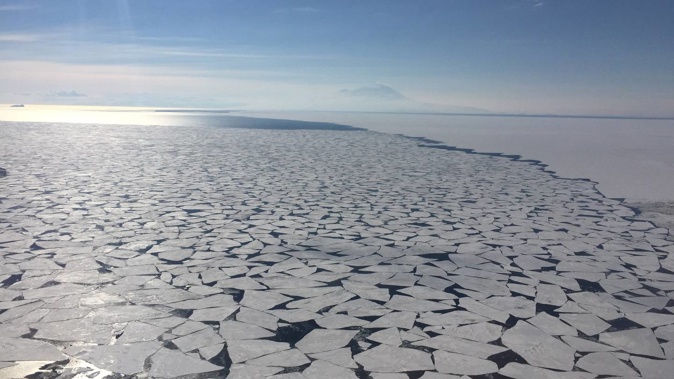
It’s being dubbed a “five-sigma event” - a one-in-7.4 million aberration so statistically unlikely one scientist has compared it with the odds of a Lotto win.
Only, there’s nothing to celebrate about the worrying and extreme state of Antarctica’s current sea ice extent – and there are now genuine questions about whether climate change has pushed this critical element of the Earth system to a tipping point.
Over past months, scientists have been observing a baffling drop in sea ice around the frozen continent which, for the first time, has been unable to recover to its usual maximum extent over the cold, dark months of winter.
The seasonal swelling and shrinking of sea ice in the Southern Hemisphere, breathing in and out like a gargantuan pair of lungs, is the largest single change to occur annually on the entire planet.
It naturally ballooned outward from Antarctica to blanket an area 50 times the size of New Zealand, reaching a maximum of 18 to 20 million square kilometres in September, and a minimum of about 3 million square kilometres in February.
This cycle helped to regulate the planet’s climate and distribute nutrient-rich water to other oceans while supporting a plethora of life, from penguins and seals to tiny krill and algae.
Right now, however, sea ice extent measured just 2.7 million square kilometres below the 1991-2020 mean.
“This is well outside its normal range of variability and is equivalent to five sigma, or standard deviations, below the mean,” said Professor Tim Naish, a leading glaciologist, climate scientist and the director of Victoria University’s Antarctic Research Centre.
“In statistical terms, this equates to a roughly one-in-7,400,000 chance. If you had predicted it, you would have won Lotto.”
Even by February, when just 2.2 million square kilometres of the Southern Ocean was covered, international scientists found there to be less sea ice in the Antarctic than at any time in the 40 years since the beginning of satellite observation.
“Most expert groups are suggesting that winter sea ice extent is now so far outside the window of natural variability that a human-induced global heating is highly likely the cause,” Naish said.
“But the southern polar atmosphere and ocean systems are highly complex and poorly understood.”
Still, Naish said Antarctica itself was now experiencing extreme events - such as a heatwave in March 2022 – and the Southern Ocean was gradually warming.
“There is also more energy in the atmosphere, so currents, winds and storms are pushing around sea ice more.”
Satellite monitoring dating back to the 1970s has helped scientists track a declining trend in Antarctic sea ice of around 2.6 per cent per decade – and 2023 marked the eighth consecutive year in which the mean extent in January has been below the long-term trend.
Victoria University climate scientist Professor James Renwick, who’s been studying sea ice trends for decades, said more data was needed to understand if this year’s occurrence was a one-off anomaly or the sign of something to come.
“Yes, it’s extremely unusual, but what’s causing it? That’s the million-dollar question.”
Renwick said recent years had seen a lot of variability in ice extent, much of which could be explained by the direction and effect of winds.
This time, it was quite possible that a warming Southern Ocean was playing a major role.
“This is super-concerning and I’ve not seen anything like it, but the one thing I’ve learned is there’s an awful lot of variability involved,” he said.
“Really, we don’t know the cause here beyond being able to say that, generally, the Earth is getting warmer and it’s getting harder and harder for sea ice to form.
“I can’t think of any other reason why you’d have so much ice missing around the Antarctic continent simultaneously, as there’s no easy answer in the way that winds have been blowing.”
In the short-term, Naish said there was a chance the sea ice extent might not recover – something Renwick wasn’t ready to make a call on.
“This could be a tipping point, whereby the powerful ice-albedo feedback continues to reduce the extent of winter sea ice by warming the ocean, such as we have seen happen in the Arctic,” Naish said.
When white sea ice was replaced by dark ocean, he explained, the Southern Ocean absorbed more heat from sunlight and warmed faster.
This amplifying feedback effect had already led to the demise of the Arctic sea ice.
“It is now not a question if, just when we will cross this threshold around Antarctica... perhaps we have.”
In the medium term, as the white, frozen ocean water around Antarctica receded, Naish said heat absorption could accelerate surface warming and destabilise ice shelves.
/cloudfront-ap-southeast-2.images.arcpublishing.com/nzme/DV6SDKV5QBF2VBZ6FC3VPC5HXE.jpg)
Antarctica's ice sheets lock up an equivalent of 60 metres of global sea level rise. Photo / Nasa
Ultimately, this could lead to the rapid and potentially unstoppable loss of up to one third of Antarctica’s ice sheets, which together store tens of metres of equivalent global sea level rise.
“Moreover, sea ice loss weakens global ocean circulation, impacting heat distribution, reducing ocean carbon storage and reducing nutrient supplies that currently support 75 per cent of global ocean production,” he said.
“As the Antarctic contracts, the tropics expand with increased heatwaves, atmospheric rivers and ex-tropical cyclones - impacting Aotearoa.”
The alarming trend comes a month after Naish and other international polar scientists called for urgent action in view of rapid changes at both ends of the planet.
“Sea ice is a highly sensitive bellwether of the state of Earth’s climate, and as such is both a key impact and early harbinger of human-induced climate change,” said Professor Ed Hanna, a leading climate scientist at the UK’s University of Lincoln.
The situation is also likely to be a major discussion point of the Australia-New Zealand Antarctic Science Conference, which is bringing more than 200 people to Christchurch this week.
Jamie Morton is a specialist in science and environmental reporting. He joined the Herald in 2011 and writes about everything from conservation and climate change to natural hazards and new technology.
Take your Radio, Podcasts and Music with you









